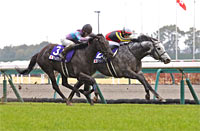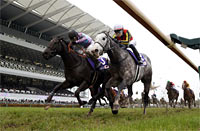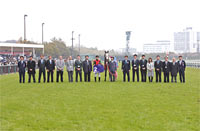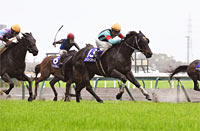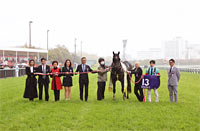Takamatsunomiya Kinen (G1) - Data Analysis
Sprint champion decider of the spring season, in which upsets have become more prominent
In the 2023 Takamatsunomiya Kinen, First Force won the race backed by win odds of 32.3 (12th favorite), while Travesura came in 3rd backed by win odds of 42.1 (13th favorite), resulting in a substantial Trifecta payout of 668,280 yen. Going further back, the 2022 and 2019 races produced even higher payouts of 2,784,560 yen and 4,497,470 yen, respectively. Furthermore, the last race favorite to live up to expectations and notch the win was Big Arthur in 2016, while the race favorites since 2017 have all fallen short, with performance of [0-1-1-5]. To gain some insights in this hard-to-call race, let’s now analyze some features shared by successful runners based on results over the last 10 years.
Runners starting in the inner brackets essentially have the edge
Of the 30 Top 3 finishers over the last 10 years, 21 entered the race with the numbers 1-9. Meanwhile, runners with the numbers 10-18 struggled somewhat with a Top 3 ratio of 10.0%. Generally speaking, therefore, we should assume that runners starting in the inner brackets generally have an advantage in the race. [Table 1]
[Table 1] Performance by horse number (last 10 years)
| Horse number |
Performance
[1st-2nd-3rd-4th or lower] |
Win ratio |
Top 2 ratio |
Top 3 ratio |
| 1-9 |
7-6-8-69 |
7.8% |
14.4% |
23.3% |
| 10-18 |
3-4-2-81 |
3.3% |
7.8% |
10.0% |
In addition, in years with good to firm track conditions (2016, 2018, 2019), all 27 runners with the numbers 10-18 were beaten to 4th or lower. In years with good track conditions (2015 and 2017), all nine such runners in 2017 were beaten to 4th or lower. This suggests we should further raise our expectations of runners starting in the inner brackets if the track conditions are expected to be good to firm or good. [Table 2]
[Table 2] Among runners with the numbers 10-18, performance by track conditions (last 10 years)
| Track conditions |
Performance
[1st-2nd-3rd-4th or lower] |
Win ratio |
Top 2 ratio |
Top 3 ratio |
| Good to firm |
0-0-0-27 |
0% |
0% |
0% |
| Good |
0-1-1-16 |
0% |
5.6% |
11.1% |
| Yielding |
2-1-1-23 |
7.4% |
11.1% |
14.8% |
| Soft |
1-2-0-15 |
5.6% |
16.7% |
16.7% |
Strong performers last time out fare well
Of the 30 Top 3 finishers over the last 10 years, 21 had finished either 1st, or with a time difference of 0.2s or less with the winner in their previous race. Conversely, runners that had finished 2nd or lower with a time difference of 0.3s or more with the winner in their previous race struggled with a Top 3 ratio of 8.4%. This trend was even more pronounced if we limit our analysis to the four years since 2020, during which the runners in this group delivered performance of [0-0-2-38] (Top 3 ratio of 5.0%). This suggests we should be skeptical of runners coming straight from a major defeat. [Table 3]
[Table 3] Performance by finish in the previous race and time difference with the winner in that race (last 10 years)
Finish in previous race and time
difference with winner in that race |
Performance
[1st-2nd-3rd-4th or lower] |
Win ratio |
Top 2 ratio |
Top 3 ratio |
| 1st, or time difference of 0.2s or less with winner |
8-8-5-51 |
11.1% |
22.2% |
29.2% |
| 2nd or lower with time difference of 0.3s or more with winner |
2-2-5-98 |
1.9% |
3.7% |
8.4% |
| Pulled up |
0-0-0-1 |
0% |
0% |
0% |
“Closing speed” in previous race also a key factor in recent years
Of the 12 Top 3 finishers in the last four years, seven had contested a JRA race in their previous race and were ranked 2nd or higher in their estimated time over the final three furlongs in that race. Runners in this group also achieved an excellent Top 3 ratio of 38.9%. We should therefore regard runners that were ranked 2nd or higher in in their estimated time over the final three furlongs in their previous race as leading contenders. [Table 4]
[Table 4] Among runners that had contested a JRA race in their previous race, performance by ranking in terms of the estimated time over the final three furlongs in that race (last four years)
Ranking by estimated time over
final three furlongs in previous race |
Performance
[1st-2nd-3rd-4th or lower] |
Win ratio |
Top 2 ratio |
Top 3 ratio |
| 2nd or higher |
2-4-1-11 |
11.1% |
33.3% |
38.9% |
| 3rd or lower |
1-0-3-44 |
2.1% |
2.1% |
8.3% |
In addition, three of the four runners that finished in the Top 3 despite having entered a JRA race in their previous race and ranking 3rd or lower in their estimated time over the final three furlongs in that race, had contested a race with a field of 18 runners at Kyoto or Hanshin Racecourse last time out. Among runners that did not rank 2nd or higher in their estimated time over the final three furlongs in their previous race, we therefore need to discount runners whose previous race was held at a venue other than Kyoto or Hanshin Racecourse, or had a field of 17 or fewer runners. [Table 5]
[Table 5] Among runners that had entered a JRA race in their previous race and ranked 3rd or lower in the estimated time over the final three furlongs in that race, performance by the racecourse of the previous race and the number of runners in the previous race (last four years)
| Racecourse of previous race and number of runners in previous race |
Performance
[1st-2nd-3rd-4th or lower] |
Win ratio |
Top 2 ratio |
Top 3 ratio |
| Kyoto or Hanshin with a field of 18 runners |
1-0-2-6 |
11.1% |
11.1% |
33.3% |
Venues other than Kyoto or Hanshin,
or races with 17 or fewer runners |
0-0-1-38 |
0% |
0% |
2.6% |
Check racing record since previous year
Of the 12 Top 3 finishers over the last four years, eight had experience of finishing in the Top 2 of a JRA G1 or G2 race since the previous year. Conversely, runners without such experience struggled with a Top 3 ratio of 9.1%. [Table 6]
[Table 6] Performance by experience of finishing in the Top 2 of a JRA G1 or G2 race since the previous year (last four years)
| Experience |
Performance
[1st-2nd-3rd-4th or lower] |
Win ratio |
Top 2 ratio |
Top 3 ratio |
| Yes |
3-3-2-20 |
10.7% |
21.4% |
28.6% |
| No |
1-1-2-40 |
2.3% |
4.5% |
9.1% |
In addition, three of the four runners that finished in the Top 3 without having experience of finishing in the Top 2 of a JRA G1 or G2 race since the previous year, had experience of finishing in the Top 4 of “a counter-clockwise JRA graded race with a field of 18 runners since the previous year.” We should therefore not expect much from runners that have not entered the top places in a JRA G1 or G2 race or in a counter-clockwise JRA graded race with a field of 18 runners since the previous year. [Table 7]
[Table 7] Among runners without experience of finishing in the Top 2 of a JRA G1 or G2 race since the previous year, performance by experience of finishing in the Top 4 of “a counter-clockwise JRA graded race with a field of 18 runners since the previous year” (last four years)
| Experience |
Performance
[1st-2nd-3rd-4th or lower] |
Win ratio |
Top 2 ratio |
Top 3 ratio |
| Yes |
1-1-1-8 |
9.1% |
18.2% |
27.3% |
| No |
0-0-1-32 |
0% |
0% |
3.0% |
Seek out the winner!
No recent wins among four-year-olds
The four winners since 2020 were all aged 5 or above. While there were no major differences in Top 3 ratios by age group in the races since 2020, we should keep in mind that four-year-olds have not produced a single winner over that period. Another shared feature among the four winners was that they had finished in their previous race either 1st, or with a time difference of 0.2s or less with the winner in that race. This suggests we should also take into consideration other trends, such as [Table 3], to narrow down win contenders. [Table 8]
[Table 8] Winners’ age, finish in the previous race, and time difference with winner in the previous race (last four years)
| Year |
Winner |
Age |
Finish in previous race |
Time difference with winner in previous race |
| 2020 |
Mozu Superflare |
5 |
4th |
0.2s |
| 2021 |
Danon Smash |
6 |
1st |
- |
| 2022 |
Naran Huleg |
6 |
2nd |
0.1s |
| 2023 |
First Force |
7 |
2nd |
No time difference |
(Masaya Ibuki)
|















